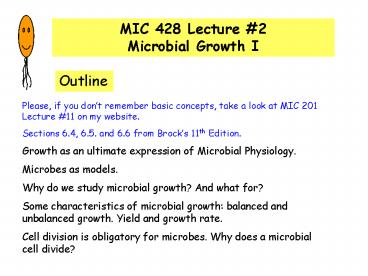MIC 428 Lecture PowerPoint PPT Presentation
1 / 23
Title: MIC 428 Lecture
1
MIC 428 Lecture 2 Microbial Growth I
Outline
Please, if you dont remember basic concepts,
take a look at MIC 201 Lecture 11 on my website.
Sections 6.4, 6.5. and 6.6 from Brocks 11th
Edition. Growth as an ultimate expression of
Microbial Physiology. Microbes as models. Why do
we study microbial growth? And what for? Some
characteristics of microbial growth balanced and
unbalanced growth. Yield and growth rate. Cell
division is obligatory for microbes. Why does a
microbial cell divide?
2
MIC 428 Lecture 2 Microbial Growth I
Outline (continuation)
Surface-to-volume ratio and genetic control. The
growth cycle and its phases. Factors that affect
the length of the lag phase Type of medium. The
processes of shift down and shift up. Inoculum
size. Physiological age of cells. Log phase and
the maximal growth rate. Stationary phase. Death
phase and the target theory.
3
Microbial growth
Growth An increase in the number of cells.
Binary fission Growth of an individual cell
continues until it divides into two new cells.
4
Growth is the ultimate expression of the
physiology of an organism.
5
Why do we study microbial growth?
Microbial growth reflects the operation of all of
the structures of an organism in a coordinated
manner.
What for?
Microbes are cells, thus, the study of microbial
growth allows us to understand the growth and
metabolism of all cells and the responses to
changes.
MODEL!
6
Some characteristics of microbial growth
Balanced growth
Unbalanced growth
How much growth has occurred?
YIELD
How fast?
RATE
7
Are there differences between microbial growth
and larger organisms growth?
Cell division is obligatory for microbes.
Studies of cell division are very important To
understand microbial life processes. To
understand the control of cell growth.
again
MODEL!
8
Why does a microbial cell divide?
1. The importance of the surface-to-volume ratio.
2. Genetic control.
3. Minimum requirements for the existence of
individual functioning cells.
9
Why does a microbial cell divide?
The importance of the surface-to-volume ratio.
By dividing, the cell restores a S /V ratio
compatible with life.
10
Why does a microbial cell divide?
Genetic control.
The cell responds by dividing, restoring an
appropriate relationship between genetic material
and protoplasm.
11
Why does a microbial cell divide?
3. Minimum requirements for the existence of
individual functioning cells.
Division occurs when sufficient synthetic
activities have occurred in growing cells to
allow a new cell to exist as a separate entity.
12
- Growth is a complicated process and it is a
function of many factors including - The of organisms present.
- The nature and concentration of nutrients.
- The genetics of the organism.
- The current physiological conditions.
- The previous story of the organism.
13
The growth cycle
Lag, exponential, stationary and death phases
Terms that apply to populations and not to
individual cells
14
Accelerated growth rate net increase in cells
but not constant. Decelerated growth phase the
rate of life and death is not equal.
15
Factors that affect the length of the lag phase.
Type of medium. The processes of shift down and
shift up. Physiological age of cells. Inoculum
size.
16
Factors that affect the length of the lag phase.
If the present environment is more nutritionally
abundant than the previous one, the change is
known as shift up. If the present environment is
nutritionally less good than the previous one,
shift down.
Which are the physiological changes the cell goes
through?
17
another situation
18
Log phase
In the log phase, the only limitation to grow is
the genetic potential of the microorganism. The
maximal growth rate.
Intrinsic property
19
Stationary phase
The reasons for entry into stationary phase are
not precisely known.
Cells drowning in their own garbage.
We may see a hump in the growth curve.
20
(No Transcript)
21
Growth parameters
N N02n
N final cell number. N0 initial cell number n
number of generations.
g t/n t hours or min of exponential growth.
log N log N0 n log 2 n log N log N0
log 2
n 3.3 (log N log N0)
22
(No Transcript)
23
Method of estimating the generation times (g) of
exponentially growing populations with generation
times of (a) 6 h and (b) 2 h from data plotted on
semi logarithmic graphs. The slope of each line
is equal to 0.301/g and n equals the number of
generations that have occurred in the time, t.
All numbers are expressed in scientific notation
that is, 10,000,000 is 1 x 107, 60,000,000 is 6 x
107, and so on.

